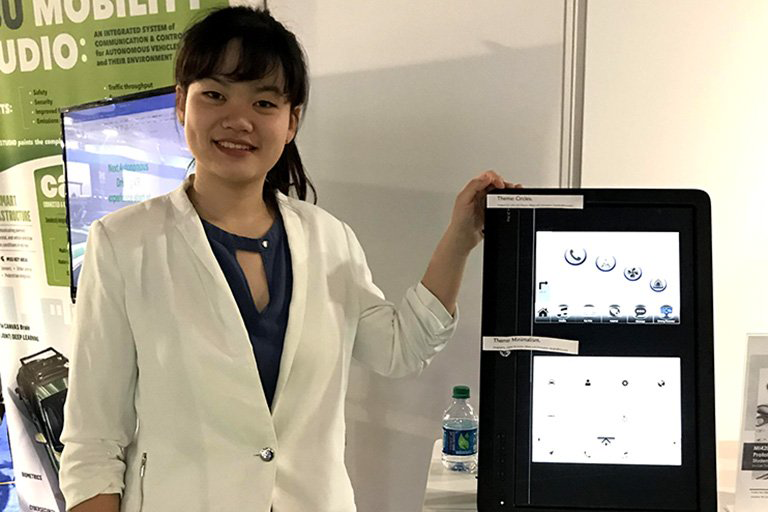Media and Information junior Jinghan Ni was brushing shoulders with industry professionals last week at the 2018 North American International Auto Show. After creating a car dashboard prototype for MI 420, her work was selected as the undergraduate student project to be presented in Detroit this month. Her work is currently being displayed along with other projects from Spartan faculty and graduate students.
Tell us about the project you took to the North American International Auto Show.
I designed an interactive touchscreen car dashboard prototype. The digital prototype is fully functional and responsive. It was displayed on a large tablet screen to allow the users to touch and interact with it to test its functionality.
How did this project come about?
This project was originally a final project for my MI 420 Interactive Prototyping class taught by Assistant Professor Taiwoo Park. For this final project, the design goal was to make a fully functional digital car interface for a specific car brand and model. I chose the Tesla Model 3. I know I am a little ambitious, but I am very passionate about this project.
During the design process, we walked through the whole design experience from user research, competitive analysis to creating a paper prototype, user testing and making the digital prototype as the final product.
The whole process felt like a project in the real industry. Park and my fellow classmates worked together in a collaborative environment; we commented on each other’s designs and shared insights. I think this is what a [educational] environment should be and I am so glad that I chose this class and had Park as my instructor.
What has the experience been like to be an undergraduate at the Auto Show?
It was an amazing experience. It is actually my first time attending the Detroit auto show. As an international student from China, I feel so proud to represent both undergraduate students from MSU and also from our awesome college.
Governor Snyder was there to listen to our presentations and I got a chance to meet him and take a picture with him. Industry attendees from Ford, Toyota and Hyundai stopped at our booth and listed to my demonstration on my car interface and gave me awesome feedback and advice. I made great connections with user experience researchers and global strategists from those companies and they are interested in learning about the university’s researchers and class curriculum.
During the exhibition, industry professionals talked about industry trends, collaboration opportunities and research potentials. I was immersed in experience and realized that there is still so much to learn and explore. I am thankful for this opportunity that both my professor and my college provided to me, and I encourage other student designers out there to not hesitate to try new things, believe in your potential and if you put the effort in and grab all of the possible opportunities, you can make things come true.
Can you tell us about the Media and Information program and why you’re interested in human computer interaction?
I think Media and Information is one of the greatest majors in the College of Communication Art and Sciences. Our program has a wide variety of concentrations coverage from film and media production to game design to human-centered technology to media management. This variety gives students a lot of freedom to become what they want to be.
Personally, I chose to focus on creating human-centered technology, which is known as user experience design and research, because I am interested in the human-centered design process and the technology field. [In addition to] completing the university general requirements and major courses like Understanding Media and Information, I took a lot of classes related to user experience. Within these courses, I gained a lot of hands on user research and design skills like conducting interviews, creating focus groups, leading user testing and creating prototypes.
I think human-computer interaction is just a cutting-edge and fascinating subject that I will never stop learning from. Knowing that humans interact with machines and technologies all the time nowadays and how this subject matters and is related to us is the reason why I love it so much. As a member of this generation, we want to make impactful and meaningful changes.
As I understand, you’re also an IT minor. Why did you decide to study that as well?
The reason I added an IT minor to supplement my major is that I learned a lot from my major about the human factor of the design and I am also interested in learning about computers, technology and machines. I realized that if I want to be a good user experience designer, I have to communicate well with all the engineers and programmers. In other words, not only to be able to understand the users (who I design for) but to also understand the engineers and programmers (who I work with) is an essential qualification for a successful designer and researcher.
I took a lot of programming classes and system design classes and collaborated with students from both the engineering college and the business college. The diversity and interdisciplinary environment makes me feel like I am working in the real industry.
What do you hope to work on in the future?
Besides continuing this car interface design project, I wish to become a user experience designer in the tech industry or learning-experience industry. My recent goals are first, to continue my education after graduating from MSU and pursue a master’s degree in human computer interaction (HCI). Second, I want to gain more experience working in the industry, which means applying for internships within the design and technology field.
I am eager to learn more about different research methods and exploring the world of computer programming, data analysis and user research. I believe the more I learn and experience, the more prepared I will be to become a good UX designer.
By Kaitlin Dudlets
